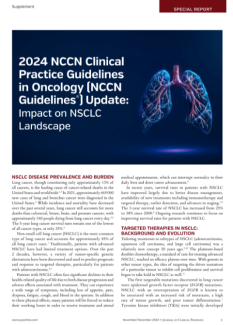Strategies to Expand Access to Genomic Testing for Patients With NSCLC
In this interview, Anne S. Tsao, MD, MBA, FASCO, FACHE, discusses the challenges of managing resistance to EGFR-targeted therapies in non-small cell lung cancer and highlights emerging strategies to overcome treatment resistance.
Please introduce yourself by stating your name, title, and any clinical experience you’d like to share.
Anne S. Tsao, MD, MBA, FASCO, FACHE: I am Anne S. Tsao, MD, MBA, FASCO, FACHE, and I am the vice president of academic affairs and a tenured professor in Thoracic & Head and Neck Medical Oncology at MD Anderson Cancer Center in Houston, Texas. I have dedicated the last 20 years to treating patients with lung cancer and previously served as the thoracic section chief, overseeing clinical research and therapeutic advancements. Additionally, I held the role of Thoracic Center medical director, managing clinical operations and patient care during the COVID-19 pandemic.
What are the key challenges in managing resistance to EGFR-targeted therapies in patients with non-small cell lung cancer (NSCLC), and what emerging strategies show the most promise?
Dr Tsao: Managing resistance to EGFR-targeted therapies remains a significant challenge, largely due to tumor heterogeneity and the variability in mechanisms of resistance (MOR) among patients. A systemic understanding of these resistance pathways is still evolving, and we lack a clear framework for the molecular drivers that enable tumors to evade targeted therapies.
Some emerging strategies to combat resistance include:
- Personalized treatment approaches based on comprehensive genomic profiling.
- Enhanced detection techniques, such as high-sensitivity liquid biopsy and real-time molecular diagnostics, to identify resistance mechanisms early.
- Advanced bioinformatics tools for rapid tumor genomic analysis, enabling faster, more precise therapy selection.
- Next-generation targeted agents designed to specifically counteract known resistance mutations and bypass pathways.
- Combination therapy strategies that integrate EGFR inhibitors with immunotherapy, chemotherapy, or other molecular targets to delay or overcome resistance.
As technology evolves, our ability to tailor treatments in real time will significantly improve, ensuring better progression-free survival and overall patient outcomes.
What advancements in next-generation sequencing (NGS) or liquid biopsy technology have most impacted your approach to treatment decision-making?
Dr Tsao: The integration of liquid biopsy into routine clinical practice has transformed how we manage patients with NSCLC, particularly in cases where obtaining a tissue biopsy is challenging or when rapid genomic insights are needed.
The key advantages to liquid biopsies include faster turnaround times, reducing delays in treatment initiation, minimized need for invasive rebiopsies, especially in patients with limited tissue availability or hard to reach areas to biopsy, and the ability to dynamically track resistance mutations, allowing for real-time therapeutic adjustments.
As liquid biopsy and NGS technologies continue to improve with faster turnaround times and higher accuracy, we can better address tumor heterogeneity, detect emerging resistance before disease progression, and even customize therapies with greater precision.
How do you counsel patients with NSCLC regarding genomic testing, particularly when insurance or access barriers arise?
Dr Tsao: Genomic testing is now the standard of care in NSCLC, and every patient should have access to comprehensive biomarker testing. When discussing genomic testing, I emphasize that patients should actively discuss genomic testing with their oncology team to ensure that appropriate molecular testing is conducted. Additionally, if a tissue biopsy is not feasible, patients should ask about liquid biopsy as a noninvasive alternative. Insurance should cover this standard-of-care assessment. However, many academic centers, industry programs, and clinical trials may offer sponsored genomic testing for eligible patients.
It is essential for all providers to educate patients on why genomic testing is critical and empower them to advocate for biomarker-driven treatment options that can significantly impact their prognosis.
What strategies can health care systems implement to ensure that biomarker-driven therapies reach all eligible patients, regardless of socioeconomic status or geographic location?
Dr Tsao: To bridge disparities in access to biomarker-driven treatments, health care systems should:
- Standardize biomarker testing as part of institutional standard operating procedures and best practices to ensure it becomes a routine aspect of NSCLC care.
- Expand clinician and patient education about emerging targeted therapies and how to access them.
- Leverage academic and university hospital networks to provide referral pathways for patients in underserved areas.
- Utilize telemedicine and digital health platforms to enable remote consults for genomic-driven treatment planning.
- Enhance payer and provider collaboration to develop policies that reduce financial barriers to comprehensive molecular testing.
- Consider mobile units that draw blood kits for liquid biopsies.
By integrating these strategies, we can ensure that patients, regardless of location or socioeconomic status, receive the most effective, biomarker-guided therapies available.
Given the long-term use of targeted therapies in NSCLC, how do you monitor patients for cumulative toxicities and ensure optimal quality of life?
Dr Tsao: Long-term use of targeted therapy requires ongoing monitoring to balance treatment efficacy with managing toxicities and preserving quality of life. Some key strategies include:
- Frequent patient communication via phone, email, telemedicine, wearable tracking devices, symptom assessment apps, and patient portals to track symptoms in real-time.
- Routine lab and imaging surveillance to identify adverse effects early, particularly cardiopulmonary, dermatologic, and gastrointestinal toxicities.
- Dose adjustments based on side effect profiles while balancing the need for optimal patient clinical outcomes.
- Multidisciplinary supportive care interventions, including oncology symptom management, rehabilitation, nutrition, pain management, sleep management, and mental health services, to address treatment-related toxicities comprehensively.
Empowering patients to actively communicate side effects and integrating real-time monitoring tools allows for personalized treatment modifications while maintaining high adherence and quality of life.
© 2025 HMP Global. All Rights Reserved.
Any views and opinions expressed are those of the author(s) and/or participants and do not necessarily reflect the views, policy, or position of the Journal of Clinical Pathways or HMP Global, their employees, and affiliates.

















